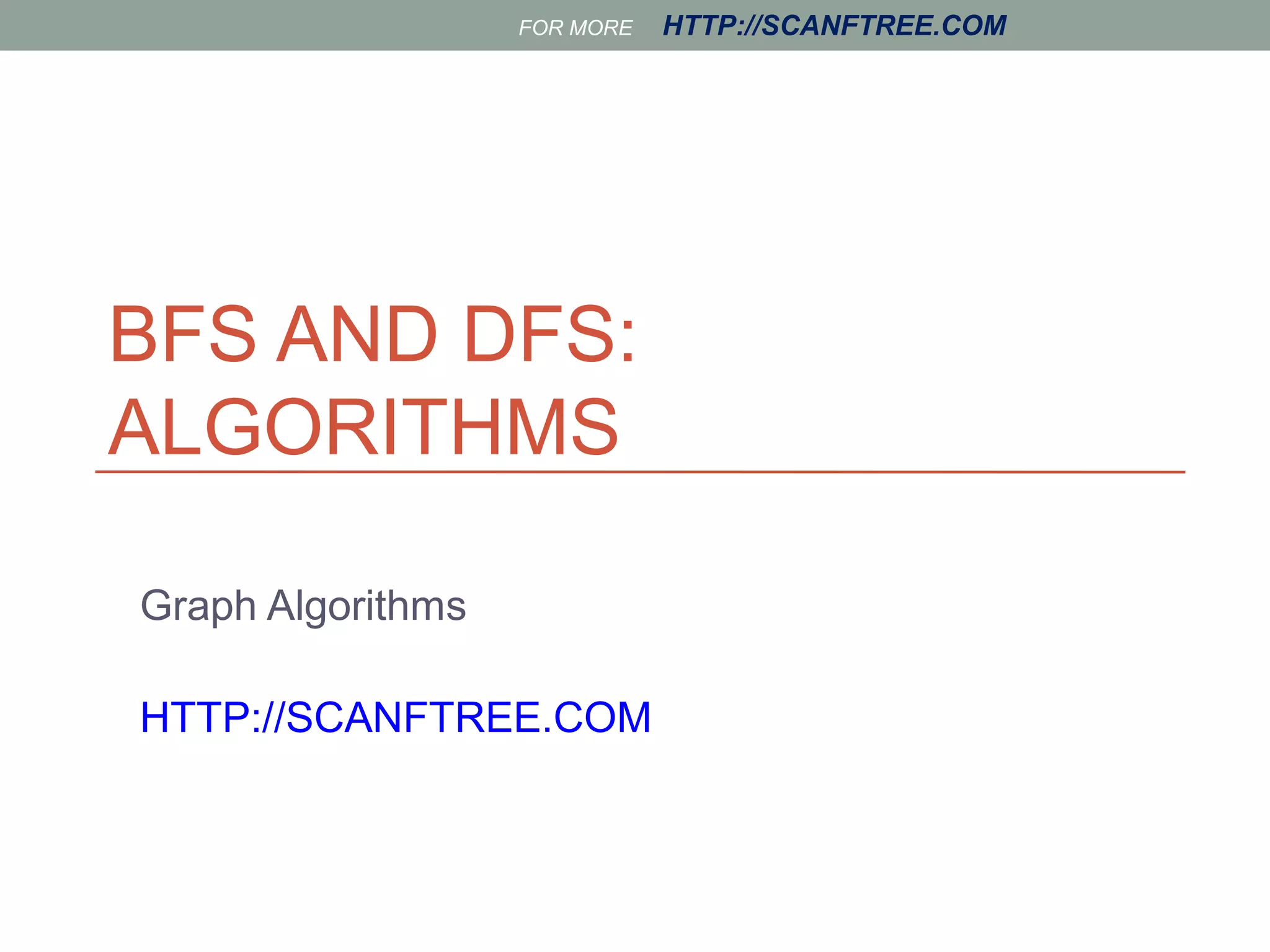The document discusses graph algorithms breadth-first search (BFS) and depth-first search (DFS). It provides pseudocode for BFS and DFS algorithms and explains key aspects of each. BFS uses a queue to explore all neighbors of a node before moving to the next level, building a breadth-first tree. DFS uses recursion to explore as deep as possible along each branch before backtracking, resulting in a depth-first tree structure. Both algorithms run in O(V+E) time on a graph with V vertices and E edges.



![FOR MORE HTTP://SCANFTREE.COM
Review: Representing Graphs
• Assume V = {1, 2, …, n}
• An adjacency matrix represents the graph as a n x n
matrix A:
• A[i, j] = 1 if edge (i, j) Î E (or weight of edge)
= 0 if edge (i, j) Ï E
• Storage requirements: O(V2)
• A dense representation
• But, can be very efficient for small graphs
• Especially if store just one bit/edge
• Undirected graph: only need one diagonal of matrix](https://image.slidesharecdn.com/bfsanddfs-140926053502-phpapp02/75/Bfs-and-dfs-in-data-structure-4-2048.jpg)



















![FOR MORE HTTP://SCANFTREE.COM
Depth-First Search: The Code
DFS(G)
{
for each vertex u Î G->V
{
u->color = WHITE;
}
time = 0;
for each vertex u Î G->V
{
if (u->color == WHITE)
DFS_Visit(u);
}
}
DFS_Visit(u)
{
u->color = GREY;
time = time+1;
u->d = time;
for each v Î u->Adj[]
{
if (v->color == WHITE)
DFS_Visit(v);
}
u->color = BLACK;
time = time+1;
u->f = time;
}](https://image.slidesharecdn.com/bfsanddfs-140926053502-phpapp02/75/Bfs-and-dfs-in-data-structure-24-2048.jpg)
![FOR MORE HTTP://SCANFTREE.COM
Depth-First Search: The Code
DFS(G)
{
for each vertex u Î G->V
{
u->color = WHITE;
}
time = 0;
for each vertex u Î G->V
{
if (u->color == WHITE)
DFS_Visit(u);
}
}
DFS_Visit(u)
{
u->color = GREY;
time = time+1;
u->d = time;
for each v Î u->Adj[]
{
if (v->color == WHITE)
DFS_Visit(v);
}
u->color = BLACK;
time = time+1;
u->f = time;
}
What does u->d represent?](https://image.slidesharecdn.com/bfsanddfs-140926053502-phpapp02/75/Bfs-and-dfs-in-data-structure-25-2048.jpg)
![FOR MORE HTTP://SCANFTREE.COM
Depth-First Search: The Code
DFS(G)
{
for each vertex u Î G->V
{
u->color = WHITE;
}
time = 0;
for each vertex u Î G->V
{
if (u->color == WHITE)
DFS_Visit(u);
}
}
DFS_Visit(u)
{
u->color = GREY;
time = time+1;
u->d = time;
for each v Î u->Adj[]
{
if (v->color == WHITE)
DFS_Visit(v);
}
u->color = BLACK;
time = time+1;
u->f = time;
}
What does u->f represent?](https://image.slidesharecdn.com/bfsanddfs-140926053502-phpapp02/75/Bfs-and-dfs-in-data-structure-26-2048.jpg)
![FOR MORE HTTP://SCANFTREE.COM
Depth-First Search: The Code
DFS(G)
{
for each vertex u Î G->V
{
u->color = WHITE;
}
time = 0;
for each vertex u Î G->V
{
if (u->color == WHITE)
DFS_Visit(u);
}
}
DFS_Visit(u)
{
u->color = GREY;
time = time+1;
u->d = time;
for each v Î u->Adj[]
{
if (v->color == WHITE)
DFS_Visit(v);
}
u->color = BLACK;
time = time+1;
u->f = time;
}
Will all vertices eventually be colored black?](https://image.slidesharecdn.com/bfsanddfs-140926053502-phpapp02/75/Bfs-and-dfs-in-data-structure-27-2048.jpg)
![FOR MORE HTTP://SCANFTREE.COM
Depth-First Search: The Code
DFS(G)
{
for each vertex u Î G->V
{
u->color = WHITE;
}
time = 0;
for each vertex u Î G->V
{
if (u->color == WHITE)
DFS_Visit(u);
}
}
DFS_Visit(u)
{
u->color = GREY;
time = time+1;
u->d = time;
for each v Î u->Adj[]
{
if (v->color == WHITE)
DFS_Visit(v);
}
u->color = BLACK;
time = time+1;
u->f = time;
}
What will be the running time?](https://image.slidesharecdn.com/bfsanddfs-140926053502-phpapp02/75/Bfs-and-dfs-in-data-structure-28-2048.jpg)
![FOR MORE HTTP://SCANFTREE.COM
Depth-First Search: The Code
DFS(G)
{
for each vertex u Î G->V
{
u->color = WHITE;
}
time = 0;
for each vertex u Î G->V
{
if (u->color == WHITE)
DFS_Visit(u);
}
}
DFS_Visit(u)
{
u->color = GREY;
time = time+1;
u->d = time;
for each v Î u->Adj[]
{
if (v->color == WHITE)
DFS_Visit(v);
}
u->color = BLACK;
time = time+1;
u->f = time;
}
Running time: O(n2) because call DFS_Visit on each vertex,
and the loop over Adj[] can run as many as |V| times](https://image.slidesharecdn.com/bfsanddfs-140926053502-phpapp02/75/Bfs-and-dfs-in-data-structure-29-2048.jpg)
![FOR MORE HTTP://SCANFTREE.COM
Depth-First Search: The Code
DFS(G)
{
for each vertex u Î G->V
{
u->color = WHITE;
}
time = 0;
for each vertex u Î G->V
{
if (u->color == WHITE)
DFS_Visit(u);
}
}
DFS_Visit(u)
{
u->color = GREY;
time = time+1;
u->d = time;
for each v Î u->Adj[]
{
if (v->color == WHITE)
DFS_Visit(v);
}
u->color = BLACK;
time = time+1;
u->f = time;
}
BUT, there is actually a tighter bound.
How many times will DFS_Visit() actually be called?](https://image.slidesharecdn.com/bfsanddfs-140926053502-phpapp02/75/Bfs-and-dfs-in-data-structure-30-2048.jpg)
![FOR MORE HTTP://SCANFTREE.COM
Depth-First Search: The Code
DFS(G)
{
for each vertex u Î G->V
{
u->color = WHITE;
}
time = 0;
for each vertex u Î G->V
{
if (u->color == WHITE)
DFS_Visit(u);
}
}
DFS_Visit(u)
{
u->color = GREY;
time = time+1;
u->d = time;
for each v Î u->Adj[]
{
if (v->color == WHITE)
DFS_Visit(v);
}
u->color = BLACK;
time = time+1;
u->f = time;
}
So, running time of DFS = O(V+E)](https://image.slidesharecdn.com/bfsanddfs-140926053502-phpapp02/75/Bfs-and-dfs-in-data-structure-31-2048.jpg)






























![FOR MORE HTTP://SCANFTREE.COM
DFS And Cycles
• How would you modify the code to detect cycles?
DFS(G)
{
for each vertex u Î G->V
{
u->color = WHITE;
}
time = 0;
for each vertex u Î G->V
{
if (u->color == WHITE)
DFS_Visit(u);
}
}
DFS_Visit(u)
{
u->color = GREY;
time = time+1;
u->d = time;
for each v Î u->Adj[]
{
if (v->color == WHITE)
DFS_Visit(v);
}
u->color = BLACK;
time = time+1;
u->f = time;
}](https://image.slidesharecdn.com/bfsanddfs-140926053502-phpapp02/75/Bfs-and-dfs-in-data-structure-62-2048.jpg)
![FOR MORE HTTP://SCANFTREE.COM
DFS And Cycles
•What will be the running time?
DFS(G)
{
for each vertex u Î G->V
{
u->color = WHITE;
}
time = 0;
for each vertex u Î G->V
{
if (u->color == WHITE)
DFS_Visit(u);
}
}
DFS_Visit(u)
{
u->color = GREY;
time = time+1;
u->d = time;
for each v Î u->Adj[]
{
if (v->color == WHITE)
DFS_Visit(v);
}
u->color = BLACK;
time = time+1;
u->f = time;
}](https://image.slidesharecdn.com/bfsanddfs-140926053502-phpapp02/75/Bfs-and-dfs-in-data-structure-63-2048.jpg)
